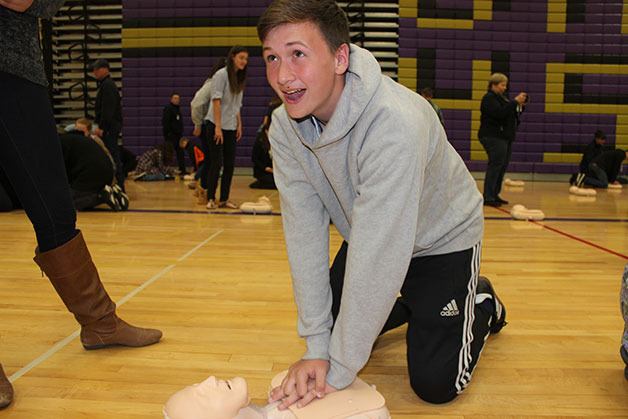Robert May has a message for teenagers: You can save a life.
The paramedic led a program Wednesday at Oak Harbor High School to teach ninth-graders how to perform CPR and use a defibrillator.
By state law, all high school students are required to receive the training before graduation. State law aside, it’s crucial to train a new generation of lifesavers who know what to do if they see someone in distress, he said.
“We’d like to train everyone on Whidbey Island,” said May of Whidbey General Hospital Emergency Medical Services. “That’s the primary way to increase survivability from cardiac arrest.”
May and his first responder colleagues held the attention of dozens of ninth-graders — no easy task. He used some funny videos and held a contest for an iTunes gift card. The students also paid close attention when he talked about an incident that rocked this community more than two decades ago.
In 1993 Keith Devlin — a fit Oak Harbor High School student and the son of former principal Dick Devlin — died of cardiac arrest after going for a run on a warm, sunny day. People passing by saw Keith sprawled in his family’s front yard, but didn’t think anything was wrong.
“I’m here to make sure that never happens again,” May told students.
Cardiac arrest is not a heart attack. It’s a short circuit of the heart. The heart suddenly stops contracting and pumping blood. It can happen to even young, healthy people.
About four times a month, emergency services personnel on Whidbey Island try to resuscitate someone in cardiac arrest. Many more are too far gone by the time help arrives.
Only one in 10 people nationally survive cardiac arrest. Statistics for Island County weren’t available, but the rate of survival in King County is higher — more than 60 percent, he said. The reason isn’t just the skill of first responders. It’s because more people in King County are trained in CPR and defibrillator use.
Here’s what you need to do if you encounter someone in distress: Check to see if they’re gasping or not breathing, call 9-1-1 and ask a bystander to see if there’s a defibrillator nearby. Then push hard and fast in the center of the chest at the rate of at least 100 times a minute. Don’t stop.
The first responders recommended pressing to the beat of the Bee Gees’ disco classic “Stayin’ Alive.” That’s about the right speed.
After the talk, students got to try out those skills on dozens of dummies in the high school gym. They took turns pressing on the dummies as “Stayin’ Alive” blasted in the background and then practiced using defibrillators.
Around 30 first responders from area fire and rescue agencies wandered among the students, answering questions and demonstrating proper technique.
The program kept the attention of ninth-grader Keith Hovde. He knew a little about CPR before the event but said he’s glad he learned more.
“I live with my grandparents,” he said. “I’d like to be able to help them if they ever need it.”
Classmate Kiara Talley said, “It would be scary if something happened.” She’s had some CPR training but said she was glad she had a chance to practice what to do.


